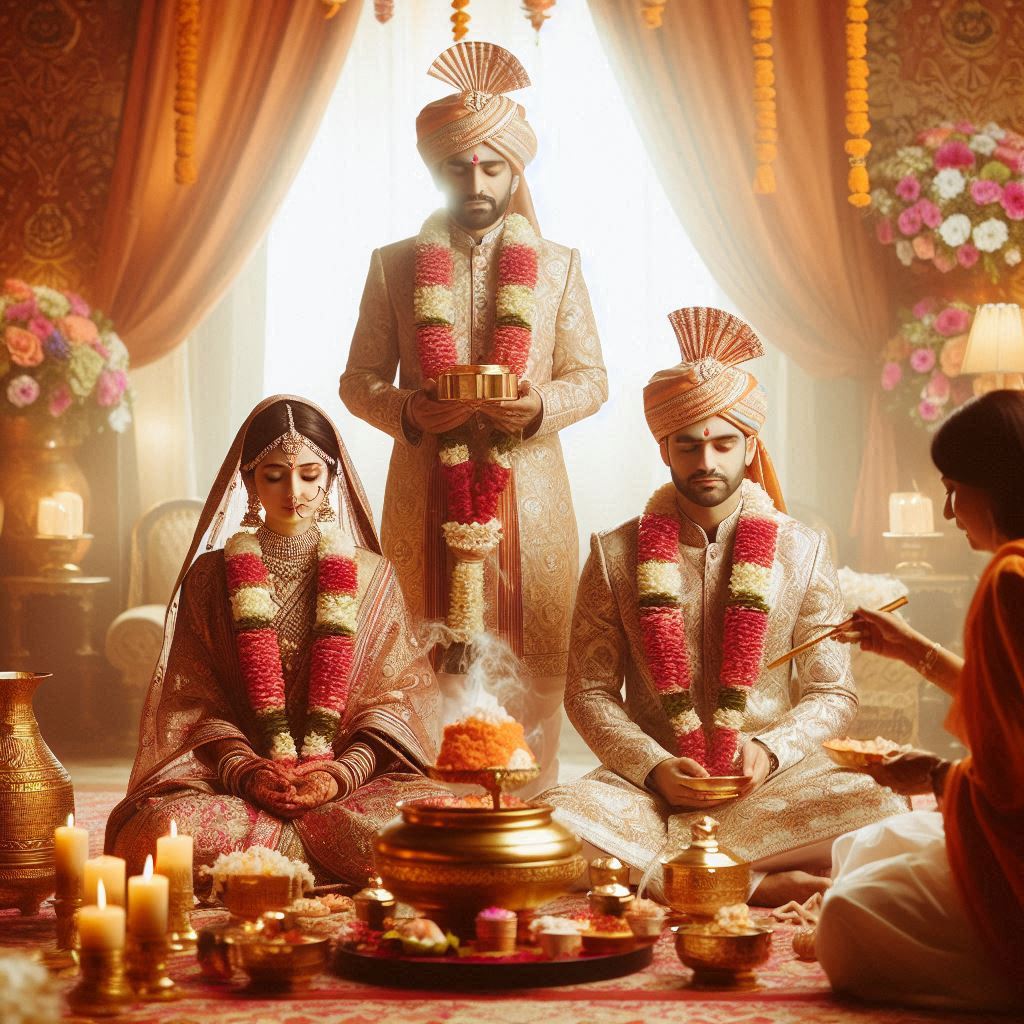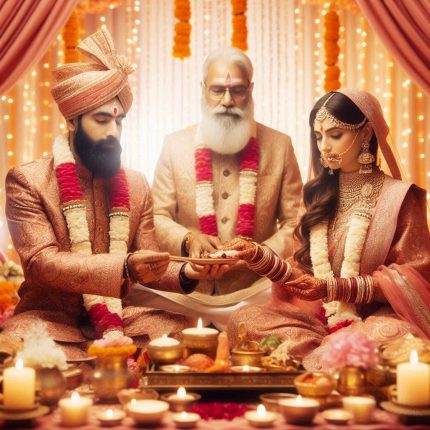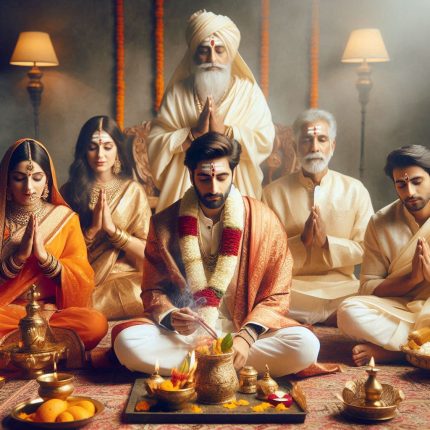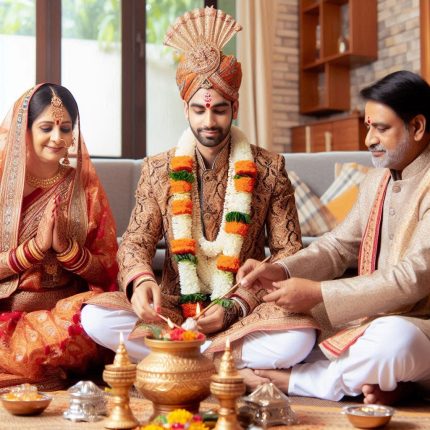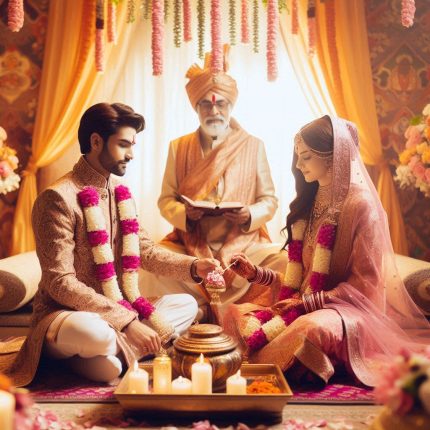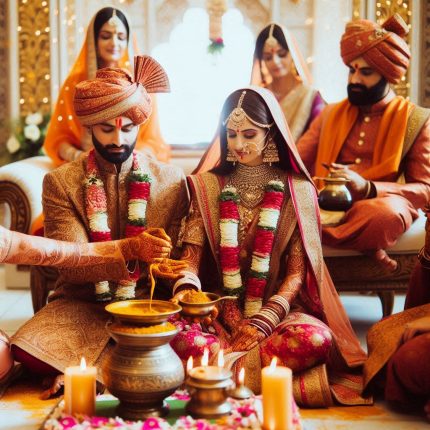Wedding Puja: The Sacred Union of Souls
Samagri
for Puja:
Haldi [organic] (20gm), Kumkum [organic] (20gm), Tulsi Mala (1), Diya Batti (5), Beetle Nuts (5), Desi Ghee (20ml), Honey (20ml), Jaggery (Gudh) (20gm), Akshata [Yellow rice] (20gm), Yagno-paveetha (5), Karpoora [camphor] (5Tabs), Red/White/Yellow Cloth(1 mtr), Prasad [Laung, Elaichi, Mishri] (20gm), Mouli (25mtr), Ganga Jal (15ml), Durva [fresh] (1), Agarbatti (6)/Dhoop (2), Dakshina (100INR), God Idols (pair), Sambrani (2), Sambrani Holder (1), Kalash [small copper] (1), Panchpatra [small copper] (1), Diya Holder (2), Panchamrit spoon (1), Karpoora Holder(1), includes perishables [Beetle Leaves [fresh] (9), Flowers [fresh] (incl mala), Tulsi [fresh], Mango Leaves [fresh] (7)]
Small Havan:
Cow Dung Cake (2), Mango Wood (250gm), HavanSamagri [20+ Grganic Herbs] (100gm), Ghee (20ml)
Yajman to provide:
Curd (100gm), Milk (100ml), Mithai (250gm), Fruits [5types], Coconut (1), HavanKund, SuchiSarva (Havan Spoon) (1), Kalash [big] (1), Bowl [preferably copper/silver] (1), Spoon [preferably copper/silver] (1), Utensils [2 big Plates (for Aarti/Samagri), disposable Plates, Bowls & Spoons], First solid food (preferably Kheer or Payasam)
Introduction
The Wedding Puja is the heart of the wedding ceremony, a sacred ritual that symbolizes the union of two souls in the presence of divine blessings. This ancient tradition plays a crucial role in sanctifying the marriage vows and ensuring a harmonious and prosperous life together. The Wedding Puja is rich in cultural and spiritual significance, marking the culmination of various pre-wedding rituals and the beginning of a new chapter in the couple’s life.
Importance and Significance of Wedding Puja
The Wedding Puja is a deeply meaningful ritual that serves several important purposes:
- Divine Blessings: The puja seeks the blessings of deities for a successful, joyous, and prosperous married life. It invokes divine protection and guidance for the couple’s journey together.
- Sacred Vows: The puja sanctifies the marriage vows, making them spiritually significant. It transforms the couple’s commitment into a sacred bond blessed by the divine.
- Cultural Tradition: The ceremony upholds cultural values and traditions, reinforcing familial bonds and preserving heritage.
- Spiritual Union: The puja symbolizes the spiritual union of the bride and groom, aligning their energies and intentions for a harmonious life together.
Benefits of Wedding Puja
Participating in the Wedding Puja offers numerous benefits:
- Blessings for Harmony: It ensures divine blessings for a harmonious and fulfilling marital life.
- Spiritual Connection: The ceremony enhances the spiritual connection between the bride and groom, reinforcing their commitment to each other.
- Cultural Enrichment: Engaging in traditional practices enriches the cultural experience and strengthens family traditions.
- Protection and Prosperity: The puja is believed to provide protection from negative influences and invite prosperity into the couple’s life.
Occasions to Perform Wedding Puja
The Wedding Puja is performed on the wedding day and is central to the wedding ceremony. It typically occurs after various pre-wedding rituals and before the couple exchanges vows and completes other marriage rites:
- Wedding Day: The puja is an integral part of the wedding day, usually performed at a temple, home, or wedding venue decorated for the occasion.
- Timing: The specific timing of the puja is often determined based on astrological considerations to ensure it aligns with auspicious planetary positions.
Wedding Puja Vidhi (Procedure)
The Wedding Puja involves a series of traditional and spiritual steps, each contributing to the sanctity of the ceremony:
- Preparation: The bride and groom dress in traditional wedding attire. The venue is decorated with flowers, lights, and sacred symbols. The puja space is set up with a sacred altar, deities’ idols or images, and offerings.
- Ganesh Puja: The ceremony typically begins with a Ganesh Puja to remove obstacles and ensure the smooth conduct of the wedding.
- Havan (Fire Ritual): The priest performs a Havan, an important fire ritual symbolizing purity and the presence of divine energy. Offerings such as ghee, grains, and herbs are made into the sacred fire.
- Vows and Rituals: The bride and groom exchange vows (saat phere) around the sacred fire, promising to uphold values such as love, loyalty, and respect. These vows are a key component of the puja, making the marriage vows spiritually binding.
- Kanyadaan: In many traditions, the bride’s father performs the Kanyadaan ritual, giving away his daughter to the groom and seeking divine blessings for their union.
- Sindoor and Mangalsutra: The groom applies sindoor (vermilion) to the bride’s forehead and ties the mangalsutra (sacred necklace) around her neck, signifying their marital status and commitment.
- Aarti and Prayers: The couple, along with their families, performs aarti and offers prayers to the deities, seeking blessings for a happy and prosperous life.
- Feast and Celebration: Following the puja, a celebratory feast and reception are often held, where family and friends gather to celebrate the newlyweds and their union.
Wedding Puja Shubh Muhurat
The Shubh Muhurat (auspicious time) for the Wedding Puja is chosen based on astrological calculations to ensure that the ceremony is performed at a favourable time. Consulting with an astrologer helps determine the most auspicious time for the puja, enhancing its spiritual significance and positive impact.
Conclusion
The Wedding Puja is a sacred and central ritual in the wedding ceremony, symbolizing the divine union of the bride and groom. It not only sanctifies the marriage vows but also invokes blessings for a harmonious and prosperous life together. By participating in this revered tradition, the couple and their families honour their cultural heritage, seek divine blessings, and celebrate the beginning of a new and cherished chapter in their lives.

